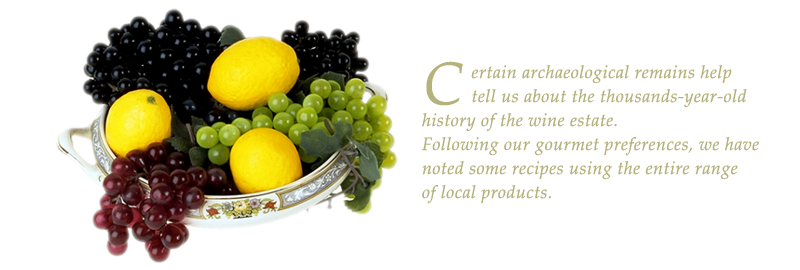RECIPES THROUGH THE AGES IN
ACCETTA CACCIA RISERVATA'S WINE ESTATE

PREHISTORY 
The first traces of human settlement in this corner of paradise in the countryside of green Statte date from the Bronze Age. Though written recipes from this period are non-existent, we know that a significant part of human subsistence came from hunting.
COOKING IN MAGNA GRAECIA 
Through the millennia we must consider the kitchen of Magna Graecia. Accetta Caccia Riservata still preserves many tombs from that age. But let’s look closer at history.
From the seventh century B.C., settlers arrived from Greece in Puglia, on the Ionian Sea. Thinking about the great Antilupo red wine we need to remember Greek wine-tasting methods. There was once a belief that wine always had to be diluted with water to prevent the destruction of the body. Fortunately this habit fell out of habit millennia ago. Various recipes have instead passed through the millennia with only small changes. Lagane pasta and chickpeas are still very much in fashion presently. The same happens with the meat of small farm animals as the oxen were working animals in the fields. One of the few exceptions is a greedy boiled beef (kàndaulos) flavored with anise seeds, bread crumbs and goat cheese.
The banquet of Magna Graecia well appreciates the game that has never been lacking in Accetta Caccia Riservata. The poet and gastronome Archestratos, from the second half of the fourth century B.C., handed us the recipe for spit-roasted rabbit, which is not too salty, and combined with olives that in Accetta Caccia Riservata have been cultivated for centuries.
COOKING IN THE MIDDLE AGES 
Now we are in the “golden age” of game in Accetta Caccia Riservata, with the wine is still on sidelines, so to speak. There is no combination of food and wine yet. The choice depends on the age of the drinkers and the type of work they do. If it is a heavy manual labor, for instance, a strong red wine would be required during the Middle Ages (third century B. C. – eighth century B. C.).
The dishes vary according to season and are as well subjected to strict rules of religious rules with alternate days of lean and fat. To represent the cuisine of the Middle Ages, we need only refer to two typical ingredients of Biorima’s vineyards found in the woods of Statte: hare and wine.
COOKING IN THE RENAISSANCE 
Art and culture are at their peaks during the Renaissance. It started at the end of the Middle Age and it went on until the Modern Age (fourteenth – sixteenth century) and it included innovations even in cooking. The dishes were enriched with spectacular mise-en-scène by cooks and craftsmen.
During the Renaissance religious rules of the Middle Ages remained, but they paid more attention to a very elaborate lean cuisine. Spices remain but gradually fade. The steaks are special foods of the table even if the taste is evolving along with the breeding habits.
In the Renaissance cuisine prevails with domestic animals like chicken and capon, mutton, pork, cow, and calf. Turkey, a new gourmet meat, comes from the Americas. Hunting is not meant to be for food any more. Over the centuries it became an elitist activity of pure entertainment for the aristocrats.
CUISINE OF LAND AND SEA 
Kissed by the sun and with a typical basket of almost limitless products, the area of Accetta Caccia Riservata’s Wine Estate has an abundance of raw materials. In earlier times, as well as in the present, these products invite us to enjoy the local cuisine. To tickle your fantasy you may want to try the Antilupo wine with fried fish, together with vegetables grown both in Statte and nearby. Here we cook them in many different and delicious ways.


